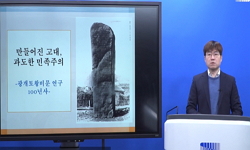Network analysis is a methodology that helps understand complex phenomena by visualizing member interactions. In the context of Eastern Jin, Sixteen Kingdoms, Song, Northern Wei period, network analysis can shed light on the position of Paekche and Ko...
http://chineseinput.net/에서 pinyin(병음)방식으로 중국어를 변환할 수 있습니다.
변환된 중국어를 복사하여 사용하시면 됩니다.
- 中文 을 입력하시려면 zhongwen을 입력하시고 space를누르시면됩니다.
- 北京 을 입력하시려면 beijing을 입력하시고 space를 누르시면 됩니다.


Exploring a New Methodology for Studying Korean Ancient History Using Network Analysis: Focusing on negotiation data from the Eastern Jin and Sixteen Kingdoms to the Song and Northern Wei period
한글로보기https://www.riss.kr/link?id=A108727418
-
저자
임동민 (고려대학교)

- 발행기관
- 학술지명
- 권호사항
-
발행연도
2023
-
작성언어
English
-
주제어
Network analysis ; Negotiation ; Paekche ; Koguryŏ ; Eastern Jin ; Sixteen Kingdoms ; Song ; Northern Wei ; Centrality ; 네트워크 분석 ; 교섭 ; 백제 ; 고구려 ; 동진 ; 16국 ; 송 ; 북위 ; 중심성
-
등재정보
KCI등재,SCOPUS,ESCI
-
자료형태
학술저널
- 발행기관 URL
-
수록면
219-258(40쪽)
- DOI식별코드
- 제공처
- 소장기관
-
0
상세조회 -
0
다운로드
부가정보
다국어 초록 (Multilingual Abstract)
The methodology for applying network analysis to ancient history involves several steps, including evaluating its suitability, quantifying the data, verifying data reliability, and analyzing and visualizing the data. Limitations of using network analysis to study ancient history include obtaining sufficient data and verifying data reliability. Ancient East Asian negotiation data is relatively more abundant than other records, making it a good candidate for network analysis. However, because negotiation data is recorded from the perspective of various actors, it is essential to verify the reliability of the data by ancient history researchers.
This paper theoretically analyzes the negotiation data of the Eastern Jin, Sixteen Kingdoms, Song, and Northern Wei periods. The negotiation network analysis reveals that Eastern Jin is the most centralized country, with Koguryŏ actively engaging in negotiations and Paekche focusing on diplomacy with Eastern Jin. The centrality analysis on the negotiation frequency data during Song and Northern Wei period shows that the Song and Northern Wei had the highest centrality in negotiation frequency among 28 countries, with Koguryŏ, Tuyuhun, and Paekche also prominent. The negotiation route analysis reveals the flow of information, with the Song having the highest betweenness centrality, Koguryŏ serving as a conduit to Shilla, and Paekche controlling the route to Mahan, Kaya, and Wa. Paekche plays a crucial role as a conduit between various regions, despite having lower centrality than Koguryŏ.
In conclusion, this paper explored the methodology of applying network analysis to ancient East Asian negotiation data and attempted to understand the structural structure of ancient East Asian negotiation networks by analyzing negotiation data from a specific time period.
Network analysis is a methodology that helps understand complex phenomena by visualizing member interactions. In the context of Eastern Jin, Sixteen Kingdoms, Song, Northern Wei period, network analysis can shed light on the position of Paekche and Koguryŏ by analyzing negotiation networks. While existing studies have focused on negotiations between these states and China, few have visualized the entire negotiation network or compared the positions of Paekche and Koguryŏ within the broader East Asian network. This paper explores the network analysis methodology for ancient East Asian negotiation data and conducts a pilot analysis of specific periods.
The methodology for applying network analysis to ancient history involves several steps, including evaluating its suitability, quantifying the data, verifying data reliability, and analyzing and visualizing the data. Limitations of using network analysis to study ancient history include obtaining sufficient data and verifying data reliability. Ancient East Asian negotiation data is relatively more abundant than other records, making it a good candidate for network analysis. However, because negotiation data is recorded from the perspective of various actors, it is essential to verify the reliability of the data by ancient history researchers.
This paper theoretically analyzes the negotiation data of the Eastern Jin, Sixteen Kingdoms, Song, and Northern Wei periods. The negotiation network analysis reveals that Eastern Jin is the most centralized country, with Koguryŏ actively engaging in negotiations and Paekche focusing on diplomacy with Eastern Jin. The centrality analysis on the negotiation frequency data during Song and Northern Wei period shows that the Song and Northern Wei had the highest centrality in negotiation frequency among 28 countries, with Koguryŏ, Tuyuhun, and Paekche also prominent. The negotiation route analysis reveals the flow of information, with the Song having the highest betweenness centrality, Koguryŏ serving as a conduit to Shilla, and Paekche controlling the route to Mahan, Kaya, and Wa. Paekche plays a crucial role as a conduit between various regions, despite having lower centrality than Koguryŏ.
In conclusion, this paper explored the methodology of applying network analysis to ancient East Asian negotiation data and attempted to understand the structural structure of ancient East Asian negotiation networks by analyzing negotiation data from a specific time period.
동일학술지(권/호) 다른 논문
-
- 고려대학교 한국사연구소
- 김상현
- 2023
- KCI등재,SCOPUS,ESCI
-
- 고려대학교 한국사연구소
- 양지혜
- 2023
- KCI등재,SCOPUS,ESCI
-
- 고려대학교 한국사연구소
- 이상록
- 2023
- KCI등재,SCOPUS,ESCI
-
Censorship and autocensorship: Some considerations on the editorial history of the Parhaego
- 고려대학교 한국사연구소
- 안드레아
- 2023
- KCI등재,SCOPUS,ESCI




 KCI
KCI DBpia
DBpia






